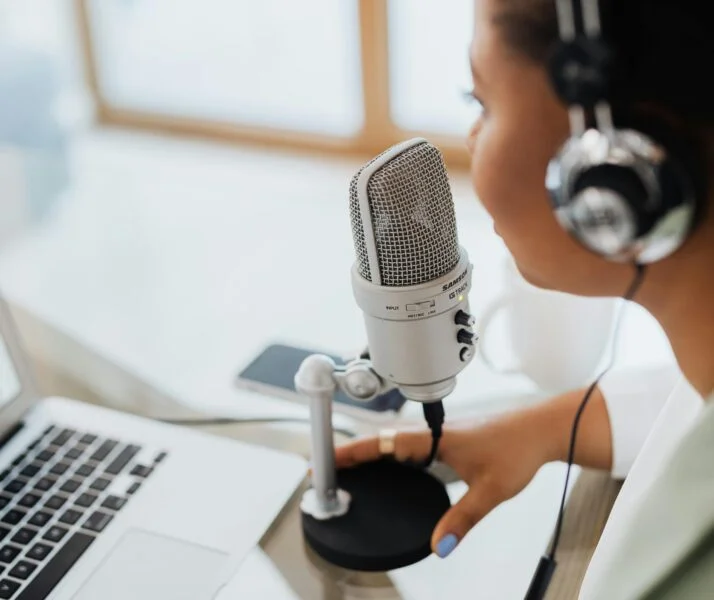
Introduction
There are many effective ways to measure success for your brand and calculate ROI from podcast advertising. As with measurement and attribution for any media channel, audio ad measurement comes with a unique set of tools and strategies that combine to paint an accurate and complete picture of podcast ads’ ROI.
Forty-seven percent of the U.S. population listens to podcasts at least monthly. As a result, audio offers significant potential to connect with consumers in a highly personal and focused manner. Adding a new channel to any media mix, however, requires testing, learning, and accurate measurement to determine how ad spend impacts business outcomes. Though podcasting is now a fully mature medium for reach and engagement, many advertisers continue to hold back investment due to concerns about the medium’s perceived measurability.
Listening time is increasing among American audiences, with the average weekly hours spent with podcasts quadrupling between 2014 and 2024. What’s more, nearly 50% of consumers have purchased a product or service after hearing about it on a podcast. The latest research indicates that advertisers are also seeing greater ROI with podcast advertising compared to other media channels—as much as 4.9x higher. This makes podcast advertising one of the most impactful media channels for marketing investment.
With advanced measurement and analysis solutions like Claritas and Podscribe now fully refined and easy to integrate into audio campaigns, it is simpler than ever to understand consumer behavior, measure attribution, and identify opportunities.
Read More: How Effective is Podcast Advertising?
How to Measure Podcast Ad Performance
There are technical challenges to measuring advertising in any channel. Luckily, proprietary and third-party solutions have rapidly evolved to meet the needs of the flourishing audio industry. With the right strategy buoyed by the right technology, advertisers can do more than measure ROI—they can have confidence, transparency, and accountability in their campaigns.
As leaders in the audio space, ARM is on the frontlines of the measurement and attribution developments that are transforming the possibilities in audio advertising. Working with hundreds of companies of all sizes, we’re privy to the most talked-about strategies and tools. Based on these conversations and our own research, we’ve identified best practices to guide your podcast ad measurement strategy.
Define your goals and timeline
Before launching any campaign, it’s critical to outline your goals and timelines. Are you looking to increase brand awareness? Generate leads? Drive sales? Your goals guide your strategies, which in turn help you determine which metrics are most crucial to measure. These KPIs help you develop winning strategies and optimize during the campaign to get the very best results.
These are some of the most common KPIs used in podcast advertising campaigns:
- Brand awareness
Measures how much a campaign increases recognition and recall of your brand. Common indicators include surveys assessing brand lift, unaided recall, and post-listen awareness. - Listener engagement
Tracks how deeply your target audience interacts with your podcast ad, often measured by completion rates (percentage of listeners who hear the ad in full) and engagement surveys. - Website traffic
Monitors spikes in visits to your website during and after the campaign. This can include unique visitors and referral data that link back to podcast ads. - Promo code usage
Measures the number of customers who use a campaign-specific promo code mentioned in your podcast ad, directly tying the ad to conversions. - Cost per acquisition (CPA)
Evaluates how much it costs to acquire a customer via your podcast ad by dividing total campaign spend by the number of new customers. - Lead generation
Assesses how effectively your campaign generates leads, typically tracked through sign-ups, inquiries, or other measurable conversions. - Return on ad spend (ROAS)
Calculates the revenue generated directly from the campaign compared to the amount spent on the ad. This is a key metric for gauging overall financial success. - Post-ad listening actions
Analyze user behaviors such as app downloads, product page visits, or other direct actions taken as a result of hearing the ad.
Align on attribution models
Choosing the right attribution models and integrating them into your campaign effectively is crucial to effectively measure KPIs. The attribution models selected will be informed by your product, overall goals, KPIs, advertising strategy, and media mix.
Some common attribution models include:
- First-click attribution
This model credits the first podcast ad heard by a listener—a great option for evaluating which ads are effectively generating awareness. - Last-click attribution
This style is similar to first-click attribution, but instead assigns credit to the last ad a listener received before making a purchase. This model is useful for measuring conversion but does not give credit to previous “touchpoints” that may have influenced a conversion or purchase. - Multi-touch attribution
This model distributes attribution across all the ads a listener was exposed to, acknowledging that each touchpoint has contributed to a conversion. In the most basic models, credit is evenly distributed across all ads. - Multi-touch time decay
Assigns credit across all ads, but gives more weight to touchpoints closer to the conversion, highlighting the importance of the most recent ads heard during the decision-making process before a listener took action.
Test and learn
Brands spend aggressively on ads because they’re effective.
Zeroing in on ad concepts, messaging, and creative strengthens the chances of a strong return. That’s why testing is so important, as it allows you to improve core concepts, gain a better understanding of segmentation, and iterate quickly. Research, as always, empowers better decisions for every campaign. Virtually any business model can structure an effective test-and-learn campaign to establish a baseline ROI for podcast advertising.
Measure podcast performance
Podcast metrics track the performance of the podcasts on which you’re advertising. Podcast performance directly impacts your advertising campaigns, so these metrics can provide insights into how your campaign is performing at a high level. Downloads, listener engagement, demographic data, and other metrics can inform businesses about how their ads are being received, their effectiveness, and opportunities to tailor ads as needed.
Direct response audio ad measurement
Direct response podcast ad measurement tactics allow businesses to track and measure the results of their efforts immediately. Direct response marketing is powerful because it quickly generates new leads and paints a clear picture of engagement. These are crucial measurement methods that work across all podcast advertising formats.
Direct response ad measurement strategies include:
Promo codes
To drive consumer trials, incentivize purchases, or enable mass sampling efforts, brands can offer a custom promo code on each podcast. A podcast host mentions the promo code in the main content of the episode, or, promo codes can be marketed with more traditional ads and companion units. These promo codes are applied upon purchase and unique to the podcast in which they are offered. For example, if a brand was advertising on The Daily and wanted to offer 10% off to listeners, the promo code could be Daily10.
Creating a unique promo code for each podcast or podcast episode is a great way to capture granular show-level data to establish which are most efficiently driving sales. For this to be effective, it is critical to ensure that your technical infrastructure supports the capability to create and track multiple unique promo codes and that your direct and third-party sales channels can accept promo codes and report usage.
Vanity URLs
Brands that want immediate conversations or to generate more broad-based consideration and engagement can measure success using vanity tracking URLs. This tried-and-true direct response tactic is just as relevant today for podcasting as it was historically for television. One way to create a more seamless transition and “warm handoff” when using vanity tracking URLs is to create custom landing pages that mention the referring content, offer, or podcast. These landing pages will reaffirm to the consumer that they are in the right place and generate goodwill by reminding them that your brand is supporting their favorite podcasts with advertising. Typically, the URL is the product or service’s generic website with a backslash and tag that is specific to the podcast. For example, if Squarespace was advertising on a podcast like 99% Invisible, the vanity URL could be squarespace.com/99percent.
Similar to ensuring that your technical infrastructure supports unique promo codes, the same rules apply to vanity tracking URLs. You must be able to generate and track vanity URLs with ease and granularity.
Surveys
Surveys are an excellent way to augment automated tracking data with self-reported responses from consumers. When a consumer makes a purchase directly from a brand or through other sales channels, asking them where they heard about the brand is a great way to attribute exposure and, just as importantly, recall and channel effectiveness.
Listening to a podcast demands one’s full attention. With 60% of listeners saying they pay attention to ads in podcasts, an advertiser’s message is often more salient and memorable than in other channels. Asking a consumer which channel they attribute their visit or purchase to can offer proof of the importance or persuasiveness of podcast advertising.
In general, surveys should be implemented during the consideration and evaluation phases in the middle of the sales funnel. Introducing survey questions during purchase can create friction and should be avoided.
Direct response + attribution based methods
Direct response and attribution-based podcast ad measurement take into account unique touchpoints that guide people to conversion. Providing insight into the customer journey with great nuance, these models can tell advertisers how much credit each ad interaction gets for conversions.
These methods include:
Pixel tracking
Pixels track exposure to an ad and subsequent website activity. One of the fundamental challenges with this method is that podcast listening often occurs offline, after the podcast episode has been downloaded. Therefore, podcast downloads are considered impressions, regardless of whether the user listened to the episode or was exposed to its ads. While this can be very frustrating, there are several third-party technical solutions that can pixel the RSS feed, which is used to download the podcast file, and track user visits to your site. As a result, this approach actualizes the ability to measure many more success metrics, including impressions, CPM, average order value (AOV), cost per acquisition (CPA), total sales, and total site visits.
Brand lift studies
For brands that do not offer consumers a direct conversion opportunity or simply want greater insight into how effectively they are communicating with new or existing audiences, brand lift studies provide a great measurement option. Brand lift studies use online surveys to measure a variety of outcomes, ranging from brand perception to purchase intent. These surveys most often use either a “pre/post” or “controlled exposure” methodology. The cost of brand lift surveys varies tremendously, but to generate meaningful data, brands should expect to invest between $5,000 and $30,000.
A pre/post survey measures the impact of the ad exposure on desired outcomes by surveying both exposed and control groups and calculating the incremental lift of the exposed group. With pre/post surveys, the primary criteria for recruitment is whether or not you have been exposed to the ad. These surveys are excellent tools for measuring ROI or ROAS.
A controlled exposure study generally measures specific aspects of ad effectiveness against a defined audience who has been conclusively exposed to an ad. When a consumer is served a controlled exposure survey, they are asked pre-qualifying questions to ensure that they fall within the correct audience segment(s). They are then asked to respond to a survey on their impressions of the ad including message, relevance, creativity, and resonance. These surveys are great tools for refining your ad strategy for your target audiences.
Common Challenges in Podcast Ad Measurement
Along with all the opportunities that come with podcast advertising, certain challenges must be overcome. Tackling these challenges requires a well-researched approach to attribution and collaboration with industry veterans who know the right tools and strategies to address them.
Some common podcast ad measurement challenges include:
- Cross-channel tracking
When ads run on numerous media channels that target specific audiences across devices, it can be difficult to gain insight into where ads are reaching them most effectively. A unified omnichannel tech stack can help advertisers tie podcast advertising to the rest of the media mix. - Incomplete or siloed data
Good data is essential to great advertising because it validates the campaign and creative behind it. Missing data throws off analysis, but advanced tech and automated systems that detect anomalies or missing fields can help course-correct and put measurement back on track.
The Future of Audio Advertising Measurement
As brands face incremental restrictions on data, privacy-safe and sustainable mediums like podcast advertising offer a high-performing solution. Podcasting’s ongoing growth, available inventory, affordability, and diversity of content make it much more than a flash in the pan. In fact, it is a foundational piece of any privacy-safe advertising future.
Audio ad tech is evolving rapidly to meet new demands in audio advertising —and it’s being developed with a privacy-first future in mind. That, however, doesn’t make it any less robust. Measurement that leverages contextual data such as time of day, weather, and content category is already improving attribution accuracy.
As marketers, we all strive to achieve full-funnel measurement that helps us understand our advertising’s impact on the consumer journey. At ARM, we’re proud to be part of the next wave of audio advertising solutions and innovate alongside creators and advertisers in this exciting medium. Our measurement specialists work with clients to develop measurement plans that utilize one or more of these methods to get a full-funnel picture that delivers results and peace of mind.
Ready to dive into audio? Let’s talk.


